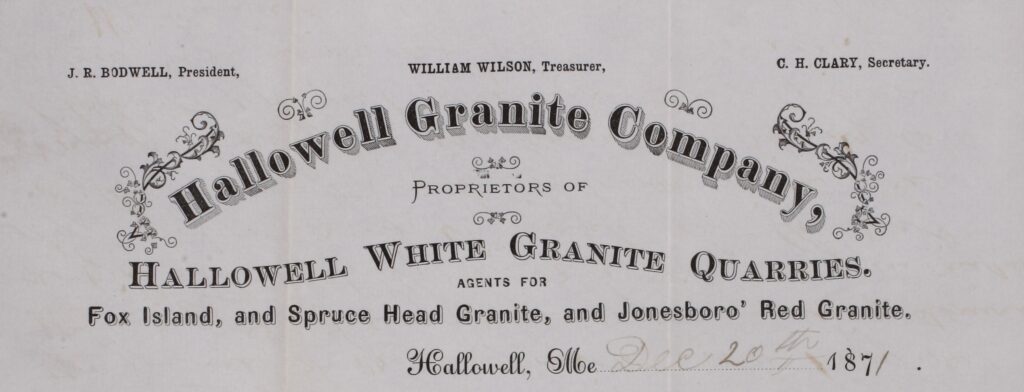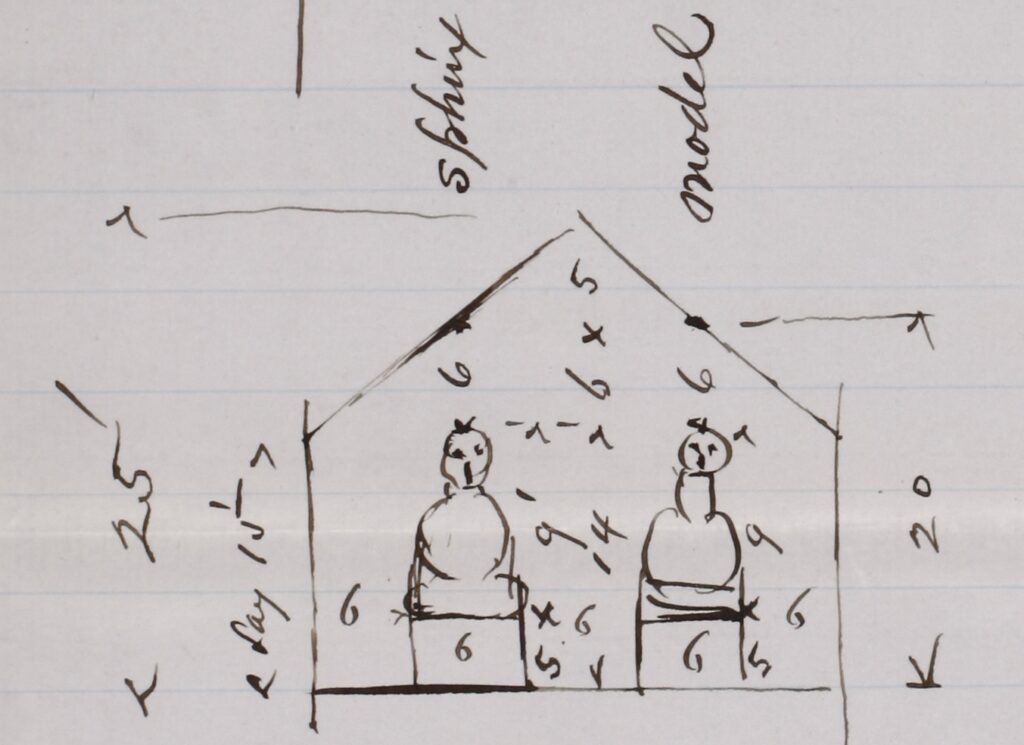History Highlight: The Sphinx

FROM THE ARCHIVES: MONUMENTS ON THE MOVE Part II: From Quarry to Carver: The Sphinx
By Kathleen M. Fox, Volunteer Researcher, Mount Auburn Historical Collections
Another grand monument hewn from a single block of granite is that of the Sphinx in front of Bigelow Chapel. This granite, from which Martin Milmore carved the Sphinx in 1872, was quarried in Hallowell, Maine. Its great journey began with twelve yoke of oxen[i] hauling the heavy block of stone from the quarry to a railroad depot in the town of Hallowell. The quarry then had to build a special railroad car to accommodate it (and sculptor Martin Milmore’s model) for the trip to Boston. Next came a transfer to a branch railroad that deposited it on a siding at Alexander McDonald’s stoneyard across the street from the Cemetery Entrance Gate at 580 Mount Auburn Street. Excerpts from the letter below from Cemetery Superintendent Charles W. Folsom to Cemetery President John T. Bradlee (September 2, 1871) describe the logistics for this massive 50- ton block of granite:
“I returned this AM from Hallowell, [Granite Co., Maine] & have to report that I discovered the Sphinx resting in its native bed, or nearly so, in the quarry 2-1/2 miles from the depot and wharf in Hallowell.
“The block in its present condition is estimated at 50 tons; it is proposed to reduce it to 35 or 40 before removing it from its present place. It will then have to be rolled or hauled by pulleys on balls or rollers about 100 or 150 feet to a more level part of the quarry, where it is to be mounted on wheels, and hauled by oxen to the cars at Hallowell, (luckily, most of the way, downhill,) 2-1/2 miles.
“It must then go on a “locomotive transportation car” to Boston. Such cars cannot always be had when wanted. The part owner of the quarry, Mr. Wilson. (one of the “Hallowell “Granite Co.,” of which the principle men are Mr. Bodwell & himself) says he shall put as many men on it as can work, (say 3 or 4,) “next week”, to “plug off” or break off the spare pieces and corners of the stone. (Nothing of this has been attempted yet.)
“He also says “if nothing “hinders”, he hopes to have the stone in Boston during September.
“But they have never moved so heavy a stone, and have had to order many things, including chains, wheels, Drills, &c, expressly for this stone; which has caused, (& probably may yet cause,) delay.
“I feel, myself, considerate doubt about his getting the stone here in that time; but will defer conjectures about that, &c until I see you…. It mostly depends on whether their heart is in it, & they shove it through regardless of other work, and of expense.”
The granite was indeed delayed! On December 20, Hallowell Granite Company wrote to Superintendent Folsom describing the reason – – a lack of snow and problems with the aforesaid hill:

“Dear Sir,
“Your favor of 13th inst. Was duly received, but we have delayed an answer hoping to be Able to report that the Stone was at the R.R.
“We have been waiting for snow and night before last got it just as we wanted. After Waiting one day for a road to make we hitched on to the stone this morning and hauled it about ¾ of a mile and coming down a hill it got the start of us & ran into the gutter and it took all the rest of the day to get it back into the road. But it is now all ready to hitch to & start again in the morn which we shall do without fail.
“We cannot tell you at just what time it will be at Mt. Auburn, for we have got to finish our part of the rough work after we get it to the Depot here where we shall be near the model, and by that time we expect that the R.R. Co. here will have a car ready [sic]to take it along to Boston as they are building one for that purpose.
“So you can judge as nearly as we can when it will be at your place. We think that the worst of our part of the job will be over when we get hauled from the Quarry and think that the rest will not take us a great while.
Very truly yours,
Hallowell Granite co.”
[Maine]By March 30, 1872, the large block of granite had finally arrived at a siding in the yard of Alexander McDonald & Co. and McDonald had volunteered to build a shed to house it, as well as the model, in his own stone yard so sculptor Martin Milmore could complete the sculpture.
“A modern Sphinx is to be at Mount Auburn Cemetery. At an unfinished building of McDonalds’ opposite Mount Auburn gate, there has lately been delivered a block of granite of colossal proportions, fourteen feet six inches in length, nine feet six inches in height, five feet eight inches wide, which is to be finished for a Sphinx with the body of a Lion and the head of a young woman. The block is partially shaped, and rough pointed, and is to be chiseled according to the proportions of a plaster cast model, furnished and delivered at the same building by that excellent Boston Sculptor, Martin Milmore…” (Cambridge Chronicle March 30, 1872-excerpt).

November 6, 1871
Once completed, the final leg of the journey included moving the Sphinx across the street, through the Egyptian Gateway, and up the hill to its final location across from the entrance of Bigelow Chapel. This work was completed by “Blair & Skinner” a Boston rigging firm at a cost of $500. Superintendent Folsom describes the process:
“August 13, 1872
Dear Sir
To move and place on pedestal the Sphinx at Mt Auburn will cost Five hundred (500) dollars. Our plan for moving would be, to raise the Sphinx with screws, then place it on rolls and move with capstan to pedestal. raise up and move over pedestal then clamp with timber and bolts placing the blocking and screws outside of the pedestal, then lower into position….
Respy Yours Blair and Skinner by G.E. Foster”
*
We leave you with this. Not all monuments that had to be teamed to the Cemetery were gigantic. Other monuments were smaller, and somewhat ordinary. For instance, a simple boulder. The charming 1897 letter from Superintendent Scorgie below explains a quaint way of sourcing what was needed:
“Aug. 20, 1897 Lot 713
Mrs. M. L. Bullard
Dear Madam:-
There is a boulder here which might answer your purpose, but as it was dug out of the soil it has not that weather beaten appearance which is desired.
The usual way is for those looking for such a thing to drive through the country and
when they find a suitable stone arrange with some person, say a neighboring farmer, to take
It to the rail road or if not too far away to this place.
If you do not care for the water stains and lichens any stone-cutter can break off for you a
stone from the quarry.
Respfy yours
Scorgie”
SOURCES
Cambridge Public Library
Mount Auburn Cemetery Historical Collections
Lead image: Stereoview of the Sphinx, Printed description on right / left borders: “BOSTON & SUBURBS, AMERICA ILLUSTRATED”
[i] Cambridge Chronicle (May 18, 1872)
Comments are closed.